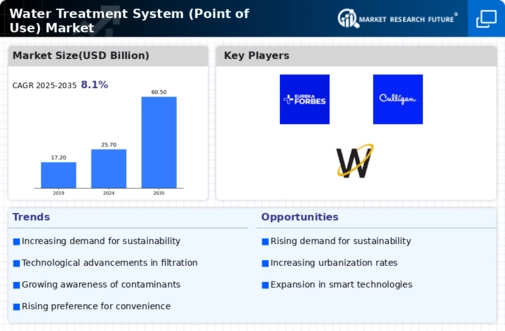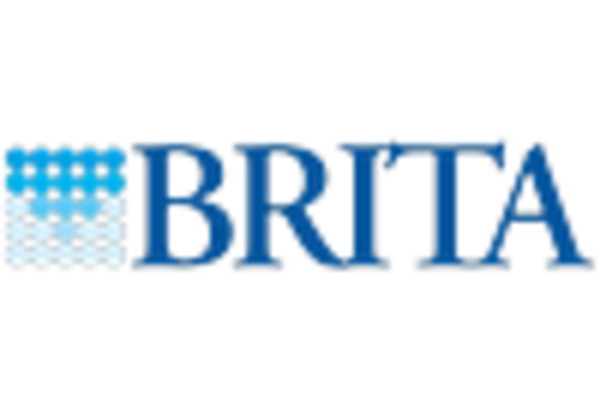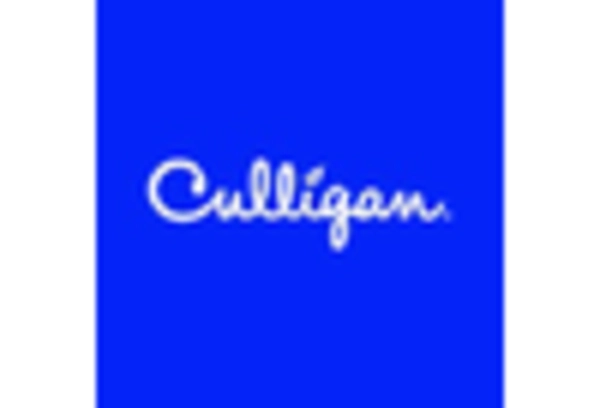Environmental Concerns
Growing environmental concerns are a significant driver for the Water Treatment System Market (Point of Use) Market. As awareness of pollution and its impact on water quality rises, consumers are increasingly motivated to invest in water treatment solutions that reduce their ecological footprint. The market is witnessing a shift towards eco-friendly systems that utilize sustainable materials and energy-efficient technologies. This trend aligns with the global push for sustainability, as consumers seek products that contribute to environmental preservation. Furthermore, regulatory bodies are encouraging the adoption of green technologies, which is likely to further stimulate market growth as consumers become more environmentally conscious.
Increasing Water Scarcity
The rising concern over water scarcity is a pivotal driver for the Water Treatment System Market (Point of Use) Market. As populations grow and urbanization accelerates, the demand for clean water intensifies. According to recent data, nearly 2 billion people live in countries experiencing high water stress. This scarcity compels households and businesses to invest in point-of-use water treatment systems to ensure access to safe drinking water. The market is projected to grow as consumers seek reliable solutions to mitigate the effects of water shortages. Furthermore, regions facing severe drought conditions are likely to see a surge in demand for these systems, as they provide an immediate remedy to the pressing issue of water availability.
Rising Disposable Incomes
Rising disposable incomes in various regions are contributing to the expansion of the Water Treatment System Market (Point of Use) Market. As individuals and families experience increased financial flexibility, they are more inclined to invest in home improvement solutions, including water treatment systems. Market analysis suggests that households are prioritizing health and wellness, leading to a greater willingness to spend on high-quality water treatment options. This trend is particularly evident in emerging economies, where the middle class is expanding rapidly. The increased purchasing power is likely to drive demand for point-of-use systems, as consumers seek reliable and effective solutions for ensuring safe drinking water.
Technological Advancements
Technological advancements play a crucial role in shaping the Water Treatment System Market (Point of Use) Market. Innovations such as advanced filtration technologies, UV purification, and smart monitoring systems enhance the efficiency and effectiveness of water treatment solutions. The integration of IoT devices allows consumers to monitor water quality in real-time, fostering a proactive approach to water safety. Market data indicates that the adoption of smart technologies is expected to increase significantly, with a projected growth rate of over 15% in the coming years. This trend not only improves user experience but also drives market growth as consumers seek modern, efficient solutions for their water treatment needs.
Health and Safety Regulations
Stringent health and safety regulations are increasingly influencing the Water Treatment System Market (Point of Use) Market. Governments and health organizations worldwide are implementing rigorous standards to ensure water quality and safety. For instance, the World Health Organization has established guidelines that necessitate the treatment of drinking water to eliminate contaminants. This regulatory landscape drives consumers and businesses to adopt point-of-use systems that comply with these standards. The market is expected to expand as compliance becomes a priority for both residential and commercial sectors. Additionally, the growing awareness of waterborne diseases further propels the demand for effective treatment solutions, as consumers prioritize health and safety in their water consumption.

















Leave a Comment